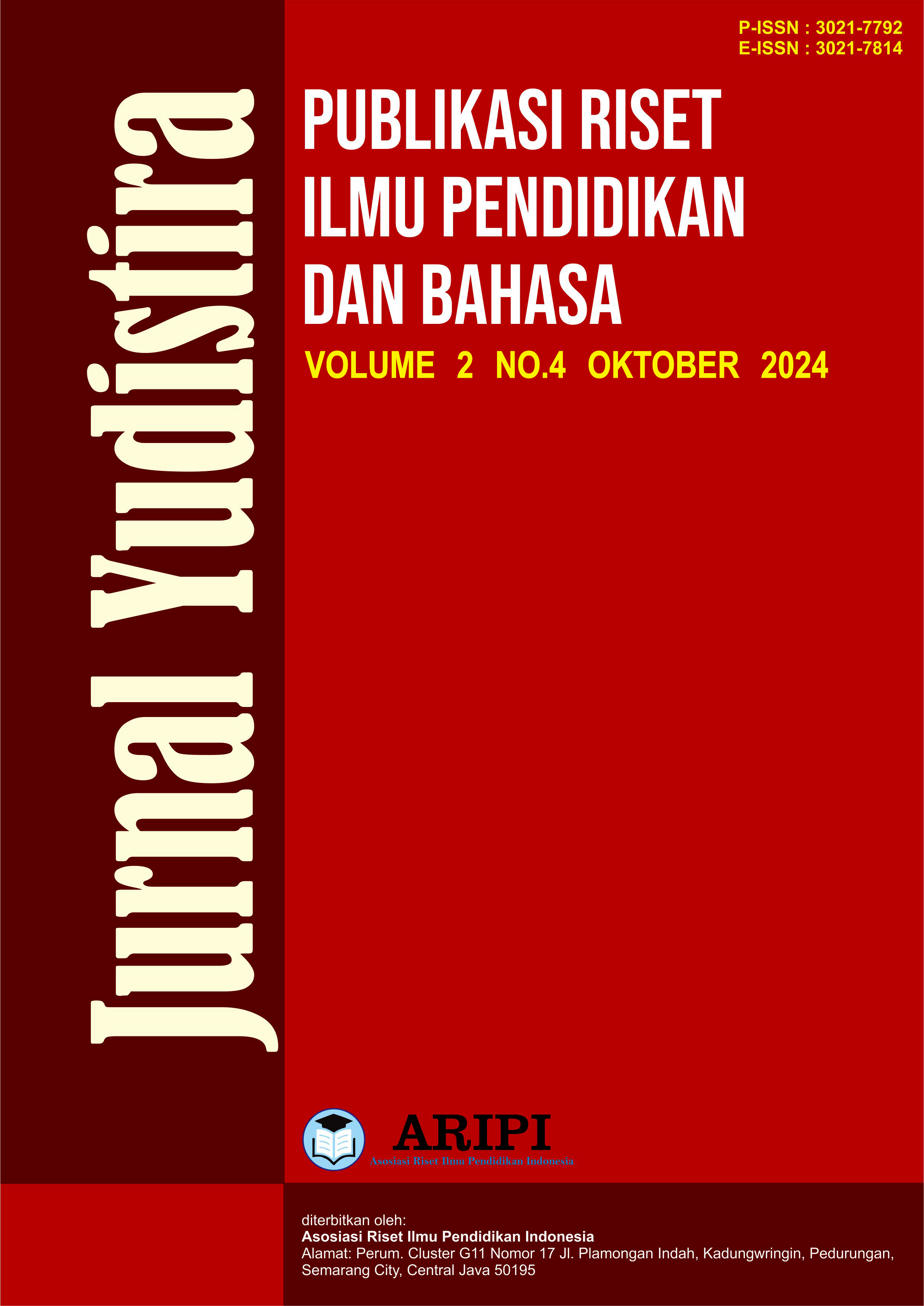The Role of Teachers in Developing Students’ Reading Comprehension Through the Implementation of Webtoon Application
DOI:
https://doi.org/10.61132/yudistira.v2i4.1236Keywords:
TARL, Learning Outcomes, MathematicsAbstract
This research aims to describe the improvement in learning outcomes in spatial volume material using the TARL approach for class IV students at SDN 01 Kanigoro. This research was carried out using a type of Classroom Action Research (PTK) which was carried out in 2 cycles which aimed to determine the increase in the completeness of student learning outcomes through the TARL learning approach. The research subjects were 12 class IV students at SDN 01 Kanigoro. The research results show an increase in student learning outcomes in mathematics subjects using the TARL approach at SDN 01 Kanigoro. Based on the results of pre-cycle action activities, there were 3 students who completed and 9 students who did not complete. In the first cycle, there were 7 students who completed and 5 students who did not complete. while in the second cycle there were 11 students who completed it and 1 student who did not complete it. In conclusion, by using the TARL approach, student learning outcomes in class can improve.
Downloads
References
Abbas Pourhosein Gilakjani, N. B. S. (2016). A Study of Factors Affecting EFL Learners’ Reading Comprehension Skill and The Strategies for Improvement. International Journal of English Linguistics, 6(5), 181–186. https://doi.org/10.5539/ijel.v6n5p180
Abida Ferindistika Putri, A., Ferindistika Putri, A., Andriningrum, H., Khusnul Rofiah, S., & Gunawan, I. (2019). Teacher Function in Class: A Literature Review. January, 2–7. https://doi.org/10.2991/icet-19.2019.2
Adams, M. J. (1994). Begining to Read: Thinking and Learning About Print. In The MIT Press.
Amin Khudlori, Achmad Bahtiar Efendi, D. K. (2022). Literasi Bahasa Inggris Siswa Sekolah Menengah Melalui Webtoon Berbasis Android di Masa Pandemi. Journal of Language and Health, 3(1), 2–6. https://doi.org/10.37287/jlh.v3i1.694
Bojovic, M. (2010). Reading Skills and Reading Comprehension in English for Specific Purposes [University of Kragujevac]. http://fl.uni-mb.si/
Brown, H. D. (2007). Principle of Language Learning and Teahcing. In Encyclopedia of the Sciences of Learning (pp. 1743–1745).
Caroline T. Linse. (2005). Practical English Language Teaching: Young Learners (David Nunan (ed.)). McGraw-Hill.
Daikh, M. (2022). Students’ Perception Towards Learning English as A Foreign Langauge Through Manga and Webtoon [Abd Elhafid Boussouf University -]. http://dspace.centre-univ-mila.dz/jspui/handle/123456789/2288
Darmawati. (2022). Aplikasi Webtoon Sebagai Media Pembelajaran Membaca. Jurnal Pendidikan Dan Pembelajaran Bahasa Indonesia, 11(2), 201–204. https://ejournal2.undiksha.ac.id/index.php/jurnal_bahasa/article/view/695
Dian Bagus Harmoko, M. S. S. (2017). Pengembangan Mobile Webtoon Pada Mata Kuliah Pemrograman Game DiUniversitas Negeri Surabaya. Jurnal IT-Edu, 2(1), 102–109.
Erwin Harianto. (2020). “Keterampilan Membaca Dalam Pembelajaran Bahasa.” Jurnal Didaktika, 9(1), 1–6. https://jurnaldidaktika.org/
Francoise Grellet. (1981). Developing Reading Skills: A Practical Guide to Reading Comprehension Exercises. In Cambridge University Press.
Harden, R. M., & Crosby, J. (2000). AMEE guide no 20: The good teacher is more than a lecturer - The twelve roles of the teacher. Medical Teacher, 22(4), 334–347. https://doi.org/10.1080/014215900409429
Haywood, H. C. (2016). Teachers as mediators. January 1985.
Jeremy Harmer. (2003). The Practice of English Language Teaching (2nd ed, Vol. 57, Issue 4). Longman.
Judy Willis, M. D. (2008). Teaching The Brain to Read: Strategies for Improving Fluency, Vocabulary, and Comprehension. In Association for Supervision and Curriculum Development.
Lee Eunkoung, Choi Myoungsik, K. C. (2015). A Study on Kitschy Characteristics and Its Consumers of Webtoon. Journal of Korea Multimedia Society, 18(8), 980–987. https://doi.org/10.9717/kmms.2015.18.8.980
Manguilimotan, R. P., Zabala, J. T., Encog, C. A., Padillo, G. G., & Capuno, R. G. (2024). Factors Affecting the Reading Comprehension Skills of Grade 3 Learners. International Journal of Social Science Research and Review, 7(3), 96–108. https://doi.org/10.47814/ijssrr.v7i3.1930
Maraghi, A. M. A. (n.d.). Tafsir Al-Maraghi 6.pdf. CV. Toha Putra Semarang.
Matthew B. Miles, A. Michael Huberman, J. S. (2014). Qualitative Data Analysis: A Methods Sourcebook. In SAGE Publications.
Middleton, K. V. (2020). The Longer‐Term Impact of COVID‐19 on K-12 Student Learning and Assessment. Educational Measurement: Issues and Practice, 39(3), 41–44. https://doi.org/10.1111/emip.12368
Mindy Gabriela, Garcia Cicerchi, Hernando Colin, C. A. (2022). The Role of Parents in Helping Arabic Teachers to Improve Students’ Vocabulary. Journal International of Lingua and Technology, 1(2), 131–139. https://doi.org/10.55849/jiltech.v1i2.83
Novi Dewi Purnama. (2015). An Investigation of Teachers’s Role as Facilitators in Teaching Writing in The Classroom. ELT Perspective, 3(2), 361–370.
Putri, A., Alfiansyah, M., Panjaitan, S. A., Siregar, A. R. P., & Br Ginting, A. M. (2023). Perintah Belajar dan Mengajar dalam Q. S. Al-‘Alaq Ayat 1-5 Menurut Tafsir Ath-Thabari. EDU-RILIGIA: Jurnal Ilmu Pendidikan Islam Dan Keagamaan, 7(3), 158–169. https://doi.org/10.47006/er.v7i3.16141
Rahman, F., Anam, A. K., & Muzaki, A. (2022). Gaya Bahasa Dalam Humor Webtoon Berjudul Tahilalats Karya Nurfadli Mursyid. Jurnal Pujangga, 8(1), 60–61. https://doi.org/10.47313/pujangga.v8i1.1619
Resy Oktadela,M. Zaim, H. (2014). Improving Students’ Reading Comprehension of Academic Texts by Using Synthesizing Strategy at Semester Iv / B of The English Departement of Fkip Uir Pekanbaru. Journal English Language Teaching (ELT), 2(1), 91–103.
Sabrina Ghina Fauziyyah, Maya Dewi Kurnia, C. H. (2022). Pemanfaatan Aplikasi Webtoon Untuk Meningkatkan Minat Baca Bagi Peserta Didik. Jubah Raja (Jurnal Bahasa, Sastra, Dan Pengajaran), 1(2), 9–16. https://www.ejurnal.ikippgribojonegoro.ac.id/index.php/JR/article/view/2870%0Ahttps://www.ejurnal.ikippgribojonegoro.ac.id/index.php/JR/article/viewFile/2870/639
Safitri, N. T., & Melati, M. (2023). EFL Learners’ Reading Comprehension Level: What Do They Portray? Scope : Journal of English Language Teaching, 7(2), 247–249. https://doi.org/10.30998/scope.v7i2.16359
Suhada, D., Fauziyyah, S. G., & Kurnia, M. D. (2022). Pemanfaatan Aplikasi Webtoon Untuk Meningkatkan Minat Baca Bagi Peserta Didik. Jurnal Jubah Raja (Jurnal Bahasa, Sastra, Dan Pengajaran), 1(2), 9–16.
Viqri Khaikal hidayatulloh, J. S. (2021). Komik Serat Tripama: Pengembangan Media Pembelajaran Berbasis Komik Digital Webtoon. Piwulang : Jurnal Pendidikan Bahasa Jawa, 9(2), 220–228. https://doi.org/10.15294/piwulang.v9i2.49828
Widiyanto, S. (2017). Peningkatan Reading Comprehension Siswa Sd Melalui Penggunaan Media Kamus Bergambar Bahasa Inggris. Jurnal Basicedu, 1(1), 74–76. https://doi.org/10.31004/basicedu.v1i1.16
Wolley, G. (2011). Reading Comprehension: Asssiting Children With Learning Difficulties. In Spinger.
Downloads
Published
How to Cite
Issue
Section
License
Copyright (c) 2024 Jurnal Yudistira : Publikasi Riset Ilmu Pendidikan dan Bahasa

This work is licensed under a Creative Commons Attribution-ShareAlike 4.0 International License.






